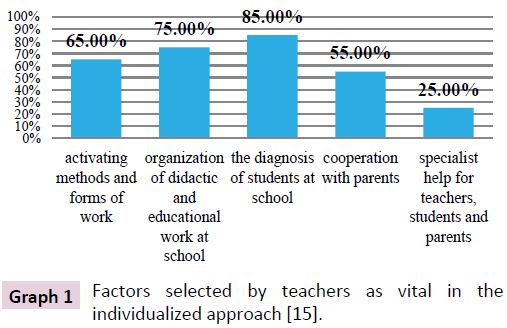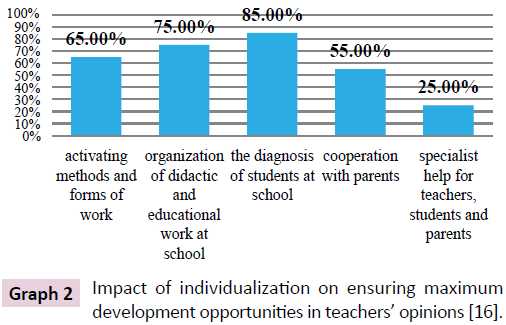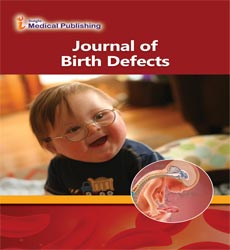Children with a Congenital Disability at School: Inclusion and Exclusion?
Pedagogium – College of Social Sciences in Warsaw, Warsaw, Poland
- *Corresponding Author:
- Magda Lejzerowicz
Pedagogium – College of Social Sciences in Warsaw, Warsaw, Poland.
E-mail: mlejzer@gmail.com
Received date: February 27, 2018; Accepted date: March 23, 2018; Published date: March 30, 2018
Citation: Lejzerowicz M (2018) Children with a Congenital Disability at School: Inclusion and Exclusion? J Birth Defects 1:2
Abstract
Introduction: The ideas of integration or inclusion have met with considerable controversy in the school environment. Teachers approaches range from acceptance, to indifference or even negation. Individualisation of instruction and education is a significant problem in the school system as well as in educational discourse and educational law.
Objectives: The aim of the article is to analyze the issue of perception of children with a congenital disability in the school environment and of a personalized and subjective approach in instruction and education associated with it. The author puts forward a thesis emphasizing the key role of the teacher, whose task is to identify developmental and educational needs and to incorporate these differences in the implementation of the didactic and educational processes.
Methods: The paper analyzes the results of research carried out by IBE TALIS, Hłobił, Galbarczyk, Lejzerowicz devoted to contemporary problems related to the process of individualization of work with people with disabilities.
Results: The research results have confirmed that teachers know what individualization is and they benefit from professional development in this field as well as in the field of working with students with special educational needs. They argue that individualization affects an increase in development opportunities and is necessary for children with disabilities. However, when implementing the process of instruction and education they favour the expository method and frontal teaching.
Conclusion: An appropriate approach to a student with a disability and to their needs, combined with a student-centred teaching based on individualized instruction, may affect the process of inclusion in the school environment. The teacher's personality, knowledge of teaching methodology and attitude to the student have a significant impact on instruction and education.
Keywords
Congenital disability; Education; Individualisation; Inclusion; Exclusion
Introduction
The education system in Poland, despite diversity, does not satisfy the educational needs of students with disabilities seeking appropriate instruction. The current system lacks an individual and subjective approach. The pupil as well as the teacher, and often also the parent, are a kind of tools or objects of the system whereas in education it is the actor that should be the subject of activities. Cervinkova proposes participatory research in action that offers a possibility of going beyond the system, which determines the need to rethink education [1].
The ideas of integration or inclusion have given rise to much controversy in the school environment. Teachers' approaches range from acceptance to indifference or even negation. There are many factors conditioning their attitude: school support, educational background, experience or perception of disability [2]. It is also worth mentioning the discrepancy between the declared and the actual stance, in both the school environment as well as the society as a whole [3].
Education to Disability?
For a child with an inborn disability starting school is a difficult experience, despite 'growing into' disability and the previous perception of self in a confrontation with others. Kruger claims that children with a congenital disability develop their own Self with regard to the existing defect. The fact that they learn about the disability gradually allows them to adapt to the situation. The resultant pain or suffering do not constitute a violent psychological trauma [4].
However, facing the school environment is a kind of border experience, with the child made to find their new way in this particular social subsystem. The new environment and the new audience are watching closely how the child will manage the situation. The child has to find the answers to the questions of how to, on the one hand, remain the individual they have been so far in the social roles they have had to perform until now andon the other-how to adapt to the new group. In this situation, the child undergoes an accelerated course of adaptation, abandons their own concept of Self and accepts what others, often significant others, offer. Not being fully a classmate, friend or student, they assume the role of a person who they fully are-a person with a disability [5]. Entering new social roles, assigned by others, re-experiencing their own disability leads to identity confusion. The situation requires reconstructing the biography into one which reflects the social opportunities, barriers, norms and rules as well as the ways of observing and overcoming them, available to the individual [6].
Disability Stigma
For a child with in-born disability and their family, disability becomes a central category shaping their whole lives. Socialization for disability can lead to the creation of a ‘wounded identity’ or, as Jakubik describes it, a homilopathic personality [7,8]. Both school and family can become a factor in the development of this type of identity. At school a child with a disability tends to be treated and perceived in a different way by teachers, parents and children. At every turn, the student can feel as inferior, unable to cope or to achieve success. The child is viewed as a second-class student, not expected to excel academically, asked in class much less often than other classmates and perceived as embarrassing and requiring constant help and attention. A student with a disability is oftentimes supposed to sit still, listen and not to interrupt. Thus, in the school environment a child with a disability has experience of themselves as dependent, incompetent, incapable of acquiring new skills or even rejected by the group. They are unable to find their way in the new reality since the newly assigned roles are far from what they have been familiar with before. They know themselves mainly from the role of being someone inferior, someone weaker, someone who needs to be looked after and is in need of help, in other words, a dependent person [9]. As the roles attributed to people with disabilities are less valuable than the roles dedicated to able-bodied individuals, they tend to fail to create a coherent and valuable picture of their own life activity [10].
Individualization and Subjectivity
Both in the family as well as at school the child acquires the basics stock of knowledge, which allows them to position themselves in a specific social space. Positive school experiences mobilize and stimulate cognitive curiosity whereas difficulties far beyond coping abilities create negative experiences which can lead to a breakdown [11] in which case the child is made to lower their aspirations and apply a defence mechanism, such as lowering values, be it social or professional, or lowering selfesteem [12,13]. In this situation, the role of significant others, supported by the educational institution or school environment, is considerable. An appropriate approach to a student with a disability and their needs combined with a subjective approach incorporating the process of individualized instruction may affect the process of inclusion in the school environment.
The attitude of teachers to students with disabilities is slowly changing, which is indicated by the fact that teachers use training courses aimed at improving work with students with disabilities. In Poland 67% of teachers in primary schools, 58%-in junior high schools and 48%-in upper secondary schools have taken part in them. Among all the respondents in TALIS teachers (junior highschools, TALIS), 32% participated in training sessions devoted to this issue. However, the need for improvement in working with special needs students is still reported by many teachers. Participation in professional development devoted to the individualization of teaching was declared by 61% of the primary school teachers, 53% of junior high school teachers and 42% of upper secondary school instructors surveyed in the study [14]. Studies carried out by Hłobił indicate that the teachers surveyed selected the following factors as vital in the individualized approach (Graph 1):
Graph 1:Factors selected by teachers as vital in the individualized approach [15].
• The diagnosis of students at school: 85%
• Organization of didactic and educational work at school: 75%
• Activating methods and forms of work: 65%
• Cooperation with parents: 55%
• Specialist help for teachers, students and parents: 25% [15].
The Polish teachers (83%) surveyed by Galbarczyk and Lejzerowicz declared that they applied individualization in the teaching process and claimed (68%) that individualization affects the increase in development opportunities (Graph 2) and as a method, seems necessary when working with children with disabilities [16].
Graph 2:Impact of individualization on ensuring maximum development opportunities in teachers’ opinions [16].
Conclusion
Changes in the teachers' approach to education of children with disabilities are indispensable and are already becoming a fact. However, teachers need a substantive support on the part of the institutions in which they work. They also should learn to cooperate with both the student and the parent as the triad of student, parent, and teacher is of utmost importance. Moreover, it seems crucial to obtain and disseminate information about good inclusion practices [17]. It would also be important to introduce an educational advisor, similar to the care manager introduced to support patients with cardiovascular disease, diabetes, heart failure. The idea of incorporating care managers into the health care system developed in project Leonardo seems to be interesting to in education of children with birth defects. The author would like to underline the importance to start new professional educational advisors, which could allow for the education plan to be individualized and to address the specific pupil’s needs [18]. An individual and subjective approach in class will be possible after rejecting the traditional teaching system and giving up the frontal method. It is only then that the teacher will have an opportunity to introduce a child-oriented instruction and a skillful and well-planned management of the student's education process. It is necessary to base education on the diversity of the phenomenon of disability, empowering all parties to this process: student, parent and teacher.
References
- Cervinkova H (2013) Teaching for social change. Participatory research in the activities of young people and ethnographic research involved: A case study. In: Gołębniak B, Kwiatkowska H (eds) Teachers program (not) preparation. Wrocław: DSW: 233 - 248.
- Avramidis E, Bayliss P, Burden R (2000) A survey into mainstream teachers' attitudes towards the inclusion of children with special educational needs in the ordinary school in one local education authority. Educational Psychology 2: 191-211.
- Lejzerowicz M, Książkiewicz I (2012) A person with a disability and aid institutions. Wroclaw: Gaskor.
- Krueger DW (1984) Psychological rehabilitation of physical trauma and disability. In: Krueger DW (ed) Rehabilitation Psychology, Rockville Md. Aspen Systems Corp: 3-13.
- Krzychała S (2007) The risk of one's own life. Individualization in late postmodernity. Wrocław: DWSE TWP.
- Nowak-Dziemianowicz M (2013) Narrative possibilities of pedagogy and the crisis of culture and education. Educational Forum 3: 35-60.
- Jakubik A (2001) Homilopathic personality. Scientific Journals WSSM 3: 53-60.
- Hulek A, Larkowa H (1974) Psychological problems in the rehabilitation of invalids. Warsaw: PZWL.
- Bakiera L, Stelter Ż (2010) Supporting the development of people with intellectual disabilities. In: Brzezińska A, Kaczan R, Smoczyńska K (eds) Diagnosis of needs and models of help for people with functional limitations. Warsaw: Scholar Publishing House: 143-162.
- Witkowski L (2000) Development and identity in the life cycle. Study of the concept of Erik H Erikson, Toruń: Wyd. J Witkowicz.
- Brejnak W (2002) For a successful student start at school. Bulletin of the Polish Society of Dyslexia 23: 38-48.
- Baranowska A (2005) People with disabilities in society. Suwałki: Suwalki Center for Teacher Training in Suwałki.
- Jakubik A (2001) Homilopathic personality. Scientific Journals WSSM 3: 53-60.
- Polish teachers and directors in the International Teaching and Learning Research TALIS 2013 (2015) Hernik K (ed) Warsaw: IBE: 35-36.
- Hłobił A (2015) Individualisation of education as a chance to realize the needs and abilities of students. Humanistic Education 1: 113-121.
- Lejzerowicz M, Galbarczyk M (2018) School and individualization. Humanistic Education 1 (38): (in print).
- Mariga L,McConkey R, Myezwa H (2014) Inclusive Education in Low-Income Countries: A resource book for teacher educators, parent trainers and community development workers. Cape Town: Atlas. Alliance and Disability Innovations Africa: 62-64.
- Ciccone MM, Aquilino A, Cortese F, Scicchitano P, Sassara M, et al. (2010) Feasibility and effectiveness of a disease and care management model in the primary health care system for patients with heart failure and diabetes (Project Leonardo). Vasc Health Risk Manag 6: 297-305.
Open Access Journals
- Aquaculture & Veterinary Science
- Chemistry & Chemical Sciences
- Clinical Sciences
- Engineering
- General Science
- Genetics & Molecular Biology
- Health Care & Nursing
- Immunology & Microbiology
- Materials Science
- Mathematics & Physics
- Medical Sciences
- Neurology & Psychiatry
- Oncology & Cancer Science
- Pharmaceutical Sciences


